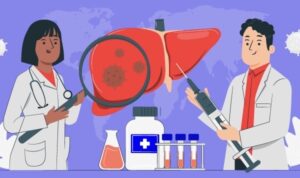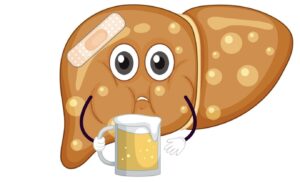
4 Critical Stages of Liver Disease
The liver plays a crucial role in maintaining our overall health and well-being. Liver disease is a serious condition that progresses through various stages, each with its own set of symptoms and implications. Understanding the four stages of liver disease is essential for early detection, proper management, and effective treatment. This article delves into the intricacies of liver disease progression, outlining the key characteristics of each stage and emphasizing the importance of timely intervention.
Stage 1: Inflammation and Hepatitis
In the initial stage of liver disease, inflammation sets in, often triggered by factors such as excessive alcohol consumption, viral infections, or autoimmune disorders. This inflammation can lead to hepatitis, characterized by liver cell damage and impaired function. Early symptoms may include fatigue, abdominal discomfort, and mild jaundice.
Progression and Symptoms
As liver inflammation progresses, individuals may experience worsening symptoms such as persistent pain in the upper right abdomen, nausea, and loss of appetite. Blood tests may reveal elevated liver enzymes, indicating ongoing liver damage. At this stage, lifestyle modifications, medication, and dietary changes can help manage symptoms and slow down disease progression.
Treatment Options
Treatment for Stage 1 liver disease focuses on addressing the underlying cause of inflammation and hepatitis. Patients are advised to abstain from alcohol, follow a healthy diet low in fat and sugar, and avoid potentially hepatotoxic medications. In some cases, antiviral medications or immunosuppressants may be prescribed to manage viral hepatitis or autoimmune-related inflammation.
| Stage 1 Liver Disease: Key Points |
|---|
| – Inflammation and hepatitis onset |
| – Symptoms: fatigue, abdominal discomfort, mild jaundice |
| – Elevated liver enzymes indicate liver damage |
| – Treatment involves lifestyle changes and medication |
Stage 2: Fibrosis Development
In Stage 2 of liver disease, prolonged inflammation leads to the accumulation of scar tissue in the liver, a process known as fibrosis. As fibrosis progresses, the liver’s ability to function normally becomes increasingly compromised. Without intervention, fibrosis can advance to cirrhosis, a more severe and irreversible stage of liver disease.
Progression and Impact
Fibrosis development is often asymptomatic in its early stages, making it challenging to detect without specialized testing. However, as scarring intensifies, individuals may experience symptoms such as unexplained weight loss, swelling in the legs and abdomen, and easy bruising or bleeding. Diagnostic tests like imaging studies and liver biopsies are used to assess the extent of fibrosis.
Management Strategies
Early detection of fibrosis is crucial for implementing interventions aimed at slowing or halting its progression. Lifestyle modifications, including weight management and regular exercise, play a vital role in managing fibrosis. Additionally, medications targeting liver inflammation and fibrosis, as well as close monitoring by healthcare providers, are essential components of treatment.
| Stage 2 Liver Disease: Key Points |
|---|
| – Fibrosis development due to prolonged inflammation |
| – Often asymptomatic in early stages |
| – Symptoms: weight loss, swelling, easy bruising |
| – Management involves lifestyle changes, medication, and monitoring |
Stage 3: Cirrhosis Formation
Cirrhosis represents an advanced stage of liver disease characterized by extensive scarring and disruption of normal liver structure and function. Chronic inflammation and fibrosis contribute to the development of cirrhosis, which significantly increases the risk of complications such as liver failure and hepatocellular carcinoma.
Symptoms and Complications
Individuals with cirrhosis may experience a range of symptoms, including fatigue, jaundice, itching, and cognitive impairment. Complications such as portal hypertension, ascites (abdominal fluid buildup), and hepatic encephalopathy can arise, posing serious health risks. Regular medical monitoring and intervention are essential to manage these complications effectively.
Treatment Approaches
Treatment for cirrhosis aims to prevent further liver damage, manage complications, and improve quality of life. Lifestyle modifications, such as sodium restriction and alcohol cessation, are crucial in reducing strain on the liver. Medications to control symptoms and address specific complications, along with potential liver transplant evaluation, form key components of cirrhosis management.
| Stage 3 Liver Disease: Key Points |
|---|
| – Extensive scarring and liver structure disruption |
| – Symptoms: fatigue, jaundice, cognitive impairment |
| – Complications: portal hypertension, ascites, hepatic encephalopathy |
| – Treatment includes lifestyle changes, symptom management, and transplant evaluation |

Stage 4: End-Stage Liver Disease
End-stage liver disease represents the most severe phase of liver dysfunction, where the liver’s ability to perform essential functions is severely compromised. At this stage, the risk of life-threatening complications, such as liver failure and hepatocellular carcinoma, is significantly heightened, necessitating urgent medical attention.
Clinical Manifestations
Symptoms of end-stage liver disease can be debilitating and include significant weight loss, extreme fatigue, confusion, and yellowing of the skin and eyes (jaundice). Individuals may also experience gastrointestinal bleeding, fluid retention, and a marked decline in overall health and well-being.
Palliative Care and Transplant Consideration
In cases of end-stage liver disease, palliative care focuses on symptom management, pain relief, and emotional support to enhance quality of life. For eligible patients, liver transplantation offers a potential cure and improved prognosis. Evaluation for transplant candidacy, adherence to treatment plans, and close monitoring are critical in end-stage liver disease management.
| Stage 4 Liver Disease: Key Points |
|---|
| – Severe liver dysfunction and life-threatening complications |
| – Symptoms: weight loss, fatigue, jaundice, confusion |
| – Palliative care emphasizes symptom management and emotional support |
| – Liver transplantation may be considered for eligible candidates |
Conclusion
Liver disease progresses through distinct stages, each presenting unique challenges and implications for patient health. Early detection, timely intervention, and comprehensive management strategies are pivotal in addressing liver disease effectively. By understanding the four stages of liver disease and their associated characteristics, healthcare providers and individuals can work together to optimize outcomes and improve quality of life for those affected by this complex condition. Vigilance, education, and proactive healthcare measures are essential in combating liver disease and promoting liver health across populations.

